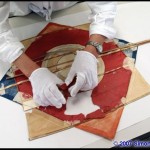The Drachen Foundation often receives generous archival donations from unexpected places. Seldom is any donation turned down, as one can never determine the worth of an object before it is seen.
 Recently, Robert Searfoss of Atlanta, Georgia, contacted the Foundation in order to donate a much-loved Japanese kite that had become too delicate for display and was beyond his scope of restoration. Thus, Searfoss sent a picture to the Foundation and shared with us a kite design that neither director Ali Fujino or board president Scott Skinner had seen before. Needless to say, the Drachen Foundation was delighted to receive this offer.
Recently, Robert Searfoss of Atlanta, Georgia, contacted the Foundation in order to donate a much-loved Japanese kite that had become too delicate for display and was beyond his scope of restoration. Thus, Searfoss sent a picture to the Foundation and shared with us a kite design that neither director Ali Fujino or board president Scott Skinner had seen before. Needless to say, the Drachen Foundation was delighted to receive this offer.
 The kite was received folded in three parts on natural fold lines and attached to a plank of wood to keep it flat and secure during travel. Syran wrap and tin foil were used to secure the kite to the plank instead of tape and to keep it dry. The brittle paper sail was cracked and had lost several pieces, though much of the paper sail is still intact.
The kite was received folded in three parts on natural fold lines and attached to a plank of wood to keep it flat and secure during travel. Syran wrap and tin foil were used to secure the kite to the plank instead of tape and to keep it dry. The brittle paper sail was cracked and had lost several pieces, though much of the paper sail is still intact.
 Searfoss had used the kite as a decorative piece, liking the bold design and recognizing it as similar to a patented cattle brand. The star-shaped paper and bamboo kite, purchased nearly 40 years ago as a decorative item, looks to be a well crafted commercial Japanese children’s kite—stamped with a “Made-in-Japan” symbol written in English. The paper is painted red, orange and navy, leaving white corners that have yellowed with age. A black target-like symbol was either hand printed or screen printed in the middle of the sail. String is glued into the edges of the square sail in order to keep the sail taut. A silver lame foil has been glued to frame this area. Though one can’t be sure, as the paper has deteriorated so much, the kite looks to have once supported a four-point bridle.
Searfoss had used the kite as a decorative piece, liking the bold design and recognizing it as similar to a patented cattle brand. The star-shaped paper and bamboo kite, purchased nearly 40 years ago as a decorative item, looks to be a well crafted commercial Japanese children’s kite—stamped with a “Made-in-Japan” symbol written in English. The paper is painted red, orange and navy, leaving white corners that have yellowed with age. A black target-like symbol was either hand printed or screen printed in the middle of the sail. String is glued into the edges of the square sail in order to keep the sail taut. A silver lame foil has been glued to frame this area. Though one can’t be sure, as the paper has deteriorated so much, the kite looks to have once supported a four-point bridle.
On the back, reinforcement papers are located at the corners. At one time, the kite had been repaired with thin piece of stiff paper. Like other traditional Japanese kites, the five bamboo vertical spars had been wrapped to ensure proper attachment to the paper. Two thin cross spars secure the top and bottom of the kite. An additional cross spar is notched at the ends in order to attach to a string glued into the edges of the kite. It looks like the cross spar may have made the kite bow a little bit.
When the Foundation receives an artifact of such cultural worth and delicacy, the first object is to draw up a plan to stabilize the piece for study. When it arrives, the package is carefully opened, with detailed photographs taken of all aspects of the piece and its packing material. Then, materials used, dimensions, and any distinguishing features are documented. Finally, the object is archivally stabilized, and a plan is developed for its future.
In the case of this kite, an archival tissue will be applied to the back of the kite to maintain the shape’s integrity. Then, the piece will be framed. Once this has happened, the object should not be removed again for study, as it is so very fragile. A detailed photograph of the kite’s backside will be archived along with the framed kite, allowing researchers access to the information without again disturbing its rest.
As this is happening, we try to collect as much information about the object as possible by talking with the previous owner or finder, contacting kite “experts,” and trying to find other examples in existence. Then, plans are drawn up for replication. Then all the information is readied and made available to kite enthusiasts worldwide.




